DIRECT Distances to Nearby Galaxies Using Detached Eclipsing Binaries and Cepheids. III. Va
写太空的作文英语50字以上
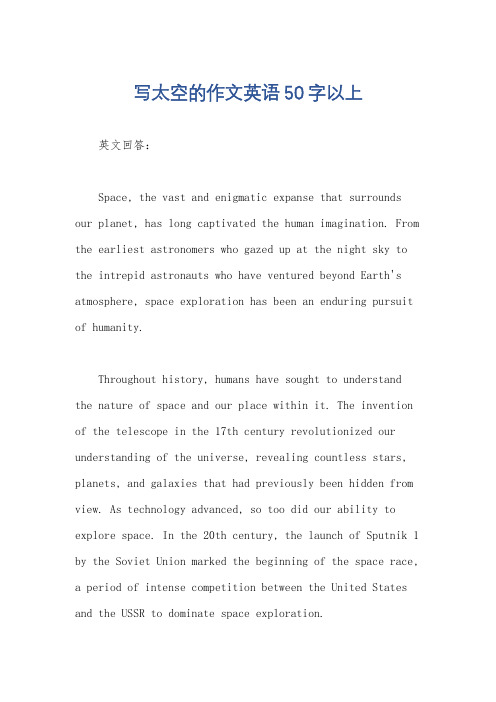
写太空的作文英语50字以上英文回答:Space, the vast and enigmatic expanse that surrounds our planet, has long captivated the human imagination. From the earliest astronomers who gazed up at the night sky to the intrepid astronauts who have ventured beyond Earth's atmosphere, space exploration has been an enduring pursuit of humanity.Throughout history, humans have sought to understand the nature of space and our place within it. The invention of the telescope in the 17th century revolutionized our understanding of the universe, revealing countless stars, planets, and galaxies that had previously been hidden from view. As technology advanced, so too did our ability to explore space. In the 20th century, the launch of Sputnik 1 by the Soviet Union marked the beginning of the space race, a period of intense competition between the United States and the USSR to dominate space exploration.The space race produced numerous technological advancements, including the development of rockets, satellites, and space suits. These innovations paved the way for the first human in space, Yuri Gagarin, who orbited Earth in 1961. Six years later, Neil Armstrong and Buzz Aldrin became the first humans to walk on the moon, a historic event that captivated the world.Since the end of the space race, international cooperation has played a significant role in space exploration. The International Space Station, a joint project of several countries, has been continuously inhabited since 2000, serving as a platform for scientific research and technological development. Space agencies from around the world are now collaborating on ambitious missions to explore the solar system and beyond, including the search for life on Mars and the study of the outer planets.Space exploration has not only expanded our knowledge of the universe but has also had a profound impact on ourlives on Earth. Satellites orbiting our planet provide essential services such as communication, navigation, and weather forecasting. Advances in space technology have also led to the development of new materials, medical treatments, and manufacturing processes.As we continue to explore the vast expanse of space, we are faced with countless challenges and opportunities. The search for extraterrestrial life remains one of the most compelling scientific endeavors, with the potential to reshape our understanding of our place in the universe. Space exploration also holds the promise of unlocking new resources and technologies that could benefit humanity in untold ways.However, space exploration is not without its risks.The vast distances, extreme temperatures, and radiation exposure present significant hazards to astronauts and spacecraft. The cost of space exploration is also a major consideration, as it requires substantial investments of time, money, and resources.Despite these challenges, the allure of spaceexploration continues to inspire us. It represents our insatiable curiosity about the unknown and our unwavering determination to push the boundaries of human knowledge and ingenuity. As we venture further into the cosmos, we will undoubtedly encounter new wonders and challenges that will shape our future and expand our understanding of the universe we inhabit.中文回答:太空,这个围绕着我们星球的浩瀚而神秘的广袤空间,长期以来都吸引着人类的想象力。
我们应该谈谈宇宙英文作文
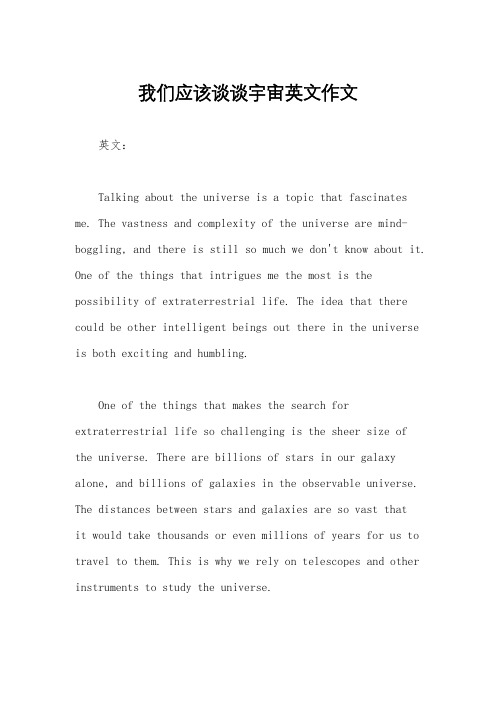
我们应该谈谈宇宙英文作文英文:Talking about the universe is a topic that fascinates me. The vastness and complexity of the universe are mind-boggling, and there is still so much we don't know about it. One of the things that intrigues me the most is the possibility of extraterrestrial life. The idea that there could be other intelligent beings out there in the universe is both exciting and humbling.One of the things that makes the search for extraterrestrial life so challenging is the sheer size of the universe. There are billions of stars in our galaxy alone, and billions of galaxies in the observable universe. The distances between stars and galaxies are so vast thatit would take thousands or even millions of years for us to travel to them. This is why we rely on telescopes and other instruments to study the universe.Another fascinating aspect of the universe is the concept of time. The universe is estimated to be around13.8 billion years old, and yet we are only able to observea tiny fraction of its history. The light from distant galaxies takes billions of years to reach us, so when we observe them, we are actually looking back in time. Thishas allowed us to study the early universe and learn about its evolution.中文:谈论宇宙是一个让我着迷的话题。
向宇宙出发作文英语

向宇宙出发作文英语标题,Embarking on a Journey to the Universe。
As humanity continues to push the boundaries of exploration, the idea of venturing beyond our own planet and exploring the vast expanse of the universe has captivated the imagination of people around the world. Embarking on a journey to the universe represents not only a scientific endeavor but also a testament to human curiosity, ingenuity, and determination.The universe, with its billions of galaxies, each containing billions of stars, has always been a source of wonder and mystery. From ancient civilizations gazing up at the night sky to modern-day astronomers peering through powerful telescopes, humanity has sought to unravel the secrets of the cosmos. Yet, despite our advancements in space exploration, much of the universe remains uncharted territory, waiting to be discovered.The journey to the universe begins with the dreamers and visionaries who dare to imagine what lies beyond the confines of our own planet. It is fueled by the tireless efforts of scientists, engineers, and astronauts who work tirelessly to overcome the challenges of space travel. From developing advanced propulsion systems to designing life support systems capable of sustaining human life in the harsh environment of space, every aspect of the journey requires innovation and expertise.One of the key milestones in humanity's quest to explore the universe is the establishment of space agencies such as NASA, ESA, and SpaceX. These organizations have played a crucial role in advancing our understanding of space and developing the technology needed to travel beyond Earth's orbit. Through missions like the Apollo moon landings, the Mars rovers, and the International Space Station, we have gained invaluable insights into the challenges and possibilities of space exploration.However, the journey to the universe is not without its risks and obstacles. Space is a hostile environment, withdangers ranging from radiation and microgravity to meteoroids and extreme temperatures. The distances involved in interstellar travel are vast, requiring spacecraft to travel at speeds approaching the speed of light to reach distant stars within a reasonable timeframe. Additionally, the long durations of space missions present challenges in terms of spacecraft reliability, crew health, and psychological well-being.Despite these challenges, the prospect of exploring the universe holds immense promise for humanity. Beyond the scientific discoveries waiting to be made, spaceexploration has the potential to inspire future generations, foster international cooperation, and spur technological innovation. It offers the opportunity to expand our horizons, both literally and figuratively, and to gain a deeper understanding of our place in the cosmos.In recent years, there has been growing interest in the concept of interstellar travel – the idea of traveling beyond our own solar system to explore other stars and planets. While still in the realm of science fiction,initiatives such as Breakthrough Starshot aim to develop the technology needed to send small, lightweight spacecraft to nearby star systems at speeds of up to 20% of the speed of light. If successful, such missions could open up entirely new avenues for exploration and discovery.In conclusion, the journey to the universe represents the culmination of centuries of human curiosity and exploration. It is a testament to our capacity for innovation, our thirst for knowledge, and our desire to push the boundaries of what is possible. While the challenges ahead are daunting, the rewards of venturinginto the unknown are immeasurable. As we look to the stars and contemplate our place in the cosmos, let us remember that the journey to the universe is not just a scientific endeavor – it is a reflection of the human spirit and our endless quest for discovery.And with each step we take towards the stars, we come closer to realizing the dream of exploring the universe and unlocking the secrets of our cosmic home. So let us embark on this journey together, with courage, curiosity, and asense of wonder, knowing that the greatest adventures still lie ahead.。
介绍太空英语作文50词

探索无垠太空:未来之门In the vast expanse of space, the universe offers a limitless frontier for human exploration. From themysteries of black holes to the wonders of distant galaxies, space exploration has captivated our imaginations and spurred scientific progress. The International SpaceStation (ISS) serves as a testbed for cutting-edge research, while spacecraft like Mars rovers explore the possibilities of extraterrestrial life. Technologies developed for space exploration have also revolutionized communication, navigation, and even daily life on Earth. As we continue to peer into the unknown, space exploration remains a powerful symbol of human curiosity and aspiration.太空是一个无垠的领域,为人类探索提供了无限的边界。
从黑洞的神秘到遥远星系的奇观,太空探索一直激发着我们的想象力,推动着科学的进步。
国际空间站(ISS)作为尖端研究的试验场,而火星探测器等航天器则探索着外星生命的可能性。
太空探索开发的技术也彻底改变了地球上的通信、导航和日常生活。
浩瀚的宇宙英语作文

浩瀚的宇宙英语作文The universe, a concept beyond comprehension, stretches beyond the limits of our imagination. It is a boundless expanse of matter and energy, encompassing stars, planets, galaxies, and countless other astronomical phenomena. The vastness of the universe is truly astounding, with its size and complexity defying our attempts to fully grasp its scale.The universe is estimated to contain over a hundred billion galaxies, each containing billions of stars. The Milky Way, our own galaxy, is just a speck in this vast ocean of stars and dust. The distances between galaxies are measured in light-years, a unit of measurement that demonstrates the immense scale of the universe. A single light-year represents the distance traveled by light in one year, which is equivalent to nearly six trillion miles.The vastness of the universe is not just a matter of size but also of time. The universe has existed forbillions of years, evolving and expanding over vast periods of time. The Big Bang, the theoretical event that marked the beginning of the universe, occurred some 13.8 billionyears ago. Since then, the universe has been expanding and cooling, giving rise to stars, planets, and the complex structures we see today.The universe is also vast in its diversity. It contains a wide range of astronomical objects, each with its unique characteristics and properties. There are giant stars that burn brightly for millions of years, dwarf stars that barely emit any light, and black holes that devour everything in their path. There are also quasars, pulsars, nebulae, and other mysterious objects that defy our understanding.The vastness of the universe also poses challenges to our understanding of the universe's origin and evolution. Scientists are constantly searching for answers to questions about the universe's beginnings, its ultimate fate, and the nature of dark matter and dark energy that make up a significant portion of the universe. The search for extraterrestrial life is also an ongoing endeavor, as we seek to understand whether life exists beyond our own planet.Despite the vastness and complexity of the universe, we can still appreciate its beauty and wonder. The night sky, filled with millions of twinkling stars, is a reminder of the universe's vastness and our own insignificant place within it. The Hubble Space Telescope and other powerful instruments have allowed us to peer deep into the universe, revealing its secrets and mysteries.In conclusion, the vastness of the universe is a profound concept that challenges our imagination and understanding. It is a reminder of the universe's infinity and our own place within it. As we continue to explore and learn more about the universe, we can only marvel at its vastness and appreciate the beauty and wonder it holds.**浩瀚的宇宙**宇宙,一个超越我们理解能力的概念,其广袤无垠超出了我们的想象。
TheMilkyWay“MilkyWay”-SFSUPhysics…

The Milky WayMilky Way probably looks likeAndromeda.The band of light we see is really 100 billion starsMilky WayBefore the 1920’s, astronomers used a “__________model” for the galaxyTried to estimate our location in the galaxy by counting stars in different __________Because some stars are _______ by dust, the true shape of this group of stars was unclear.A Globular ClusterFinding the Centerthe Solar System.The Milky WayParts of OurGalaxyDisk: The ____ Resides in theNuclear Bulge: The dense_______ regionHalo: Spherical regionsurrounding the disk where the_______ ________ live.Questions:How big is the Milky Way?Where are stars forming (or not forming)?How much mass is in the Milky Way?What’s going on at the center?so stars are still forming Car Headlights are standard candles:We use them to determine the car’s distanceHenrietta Leavitt Cepheid stars change in brightness. They pulsate in a very regular way. Large, bright Cepheids pulsate_____, while small, dim Cepheids pulsate _______.Milky Way Galaxy, we map out its structureA modern map of the Milky WayMeasuring the Mass of the Milky WayWe use the Sun’s ______around the center of the MilkyWayThe greater the mass insidethe orbit, the ______ the Sunhas move around the center.This way we can measure themass of the Milky Way.Total mass: about ___ _______ MThe Center of the Milky Wayat the center of the galaxy!Chapter 13Galaxies____)M 100NGC 300Less gas and dustAre generally ______ than spirals and ellipticals_______ Galaxies (E): Classified according to shape (E0-E9)_______ GalaxiesA Barred Spiral Galaxy with only 2 arms.Candles••Supernova in galaxy NGC4526 (HST Image)Hubble’s Original DataHubble Law/ Hd = vrClassifying Galaxies Lecture Tutorial: Page 127•Work with a partner or two•Read directions and answer all questions carefully. Take time to understand it now!•Discuss each question and come to a consensus answer you all agree on before moving on to the next question.•If you get stuck, ask another group for help.•If you get really stuck, raise your hand and I will come around.。
新概念第四册课文翻译及学习笔记【Lesson43、44、45】

【导语】新概念英语作为⼀套世界闻名的英语教程,以其全新的教学理念,有趣的课⽂内容和全⾯的技能训练,深受⼴⼤英语学习者的欢迎和喜爱。
为了⽅便同学们的学习,⽆忧考为⼤家整理了⾯的新概念第四册课⽂翻译及学习笔记,希望为⼤家的新概念英语学习提供帮助!Lesson43 【课⽂】 First listen and then answer the following question. 听录⾳,然后回答以下问题。
What does the 'uniquely rational way' for us to communicate with other intelligent beings in space depend on? We must conclude from the work of those who have studied the origin of life, that given a planet only approximately like our own, life is almost certain to start. Of all the planets in our solar system, we ware now pretty certain the Earth is the only one on which life can survive. Mars is too dry and poor in oxygen, Venus far too hot, and so is Mercury, and the outer planets have temperatures near absolute zero and hydrogen-dominated atmospheres. But other suns, start as the astronomers call them, are bound to have planets like our own, and as is the number of stars in the universe is so vast, this possibility becomes virtual certainty. There are one hundred thousand million starts in our own Milky Way alone, and then there are three thousand million other Milky Ways, or galaxies, in the universe. So the number of the stars that we know exist is now estimated at about 300 million million million. Although perhaps only 1 per cent of the life that has started somewhere will develop into highly complex and intelligent patterns, so vast is the number of planets, that intelligent life is bound to be a natural part of the universe. If then we are so certain that other intelligent life exists in the universe, why have we had no visitors from outer space yet? First of all, they may have come to this planet of ours thousands or millions of years ago, and found our then prevailing primitive state completely uninteresting to their own advanced knowledge. Professor Ronald Bracewell, a leading American radio astronomer, argued in Nature that such a superior civilization, on a visit to our own solar system, may have left an automatic messenger behind to await the possible awakening of an advanced civilization. Such a messenger, receiving our radio and television signals, might well re-transmit them back to its home-planet, although what impression any other civilization would thus get from us is best left unsaid. But here we come up against the most difficult of all obstacles to contact with people on other planets -- the astronomical distances which separate us. As a reasonable guess, they might, on an average, be 100 light years away. (A light year is the distance which light travels at 186,000 miles per second in one year, namely 6 million million miles.) Radio waves also travel at the speed of light, and assuming such an automatic messenger picked up our first broadcasts of the 1920's, the message to its home planet is barely halfway there. Similarly, our own present primitive chemical rockets, though good enough to orbit men, have no chance of transporting us to the nearest other star, four light years away, let alone distances of tens or hundreds of light years. Fortunately, there is a 'uniquely rational way' for us to communicate with other intelligent beings, as Walter Sullivan has put it in his excellent book, We Are not Alone. This depends on the precise radio frequency of the 21-cm wavelength, or 1420 megacycles per second. It is the natural frequency of emission of the hydrogen atoms in space and was discovered by us in 1951; it must be known to any kind of radio astronomer in the universe. Once the existence of this wave-length had been discovered, it was not long before its use as the uniquely recognizable broadcasting frequency for interstellar communication was suggested. Without something of this kind, searching for intelligences on other planets would be like trying to meet a friend in London without a pre-arranged rendezvous and absurdly wandering the streets in the hope of a chance encounter. ANTHONY MICHAELIS Are There Strangers in Space? from The Weekend Telegraph 【New words and expressions ⽣词和短语】 Mercury n. ⽔星 hydrogen n. 氢⽓ prevailing adj. 普遍的 radio astronomer 射电天⽅学家 uniquely adv. 地 rational adj. 合理的 radio frequency ⽆线电频率 cm n. 厘⽶ megacycle n. 兆周 emission n. 散发 intersteller adj.星际的 rendezvous n. 约会地点 【课⽂注释】 1.that given a planet only approximately like our own, life is almost certain to start 这是⼀个宾语从句,作动词conclude的宾语,其中given a planet…our own,过去分词短语作条件状语,given与if的意思相近,这个过去分词短语可译成“如果⼀个⾏星与我们所在的⾏星⼤致相同的话”。
宇宙旅行的科幻作文英语
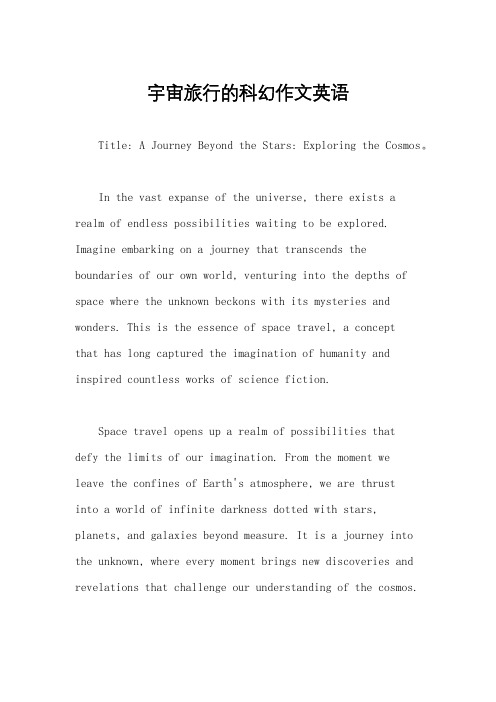
宇宙旅行的科幻作文英语Title: A Journey Beyond the Stars: Exploring the Cosmos。
In the vast expanse of the universe, there exists a realm of endless possibilities waiting to be explored. Imagine embarking on a journey that transcends the boundaries of our own world, venturing into the depths of space where the unknown beckons with its mysteries and wonders. This is the essence of space travel, a conceptthat has long captured the imagination of humanity and inspired countless works of science fiction.Space travel opens up a realm of possibilities thatdefy the limits of our imagination. From the moment weleave the confines of Earth's atmosphere, we are thrustinto a world of infinite darkness dotted with stars, planets, and galaxies beyond measure. It is a journey into the unknown, where every moment brings new discoveries and revelations that challenge our understanding of the cosmos.As we venture deeper into space, we encounter celestial bodies that are both familiar and alien. Planets with landscapes unlike anything found on Earth, moons shroudedin mysterious mists, and asteroids that tell the story of the universe's turbulent history. Each discovery brings us closer to unlocking the secrets of the cosmos and understanding our place within it.But space travel is not without its challenges. The vast distances between stars and galaxies mean that journeys can take years, even decades, to complete. The harsh conditions of space, from extreme temperatures to cosmic radiation, pose significant risks to the safety of astronauts. Yet, it is these very challenges that drive us forward, pushing the boundaries of what is possible and inspiring us to reach for the stars.One of the most intriguing aspects of space travel is the possibility of encountering extraterrestrial life. While the search for life beyond Earth remains ongoing, the discovery of even the simplest forms of life would revolutionize our understanding of the universe and ourplace within it. It is a prospect that both excites and terrifies, raising questions about our own existence and the nature of life itself.But perhaps the greatest reward of space travel is the perspective it offers. Looking back at Earth from the depths of space, astronauts experience a profound sense of awe and humility. They see our planet not as a collection of nations divided by borders, but as a single, fragile world suspended in the vastness of the cosmos. It is a reminder of the importance of working together to preserve and protect our shared home.In the end, space travel is more than just a journey to distant stars and galaxies. It is a testament to the indomitable spirit of humanity, a relentless quest for knowledge and understanding that transcends the boundaries of time and space. As we continue to explore the cosmos, we carry with us the hopes and dreams of generations past, paving the way for a future where the wonders of the universe are ours to discover and cherish.。
大学英语读写试卷 (6)

第1页 共 12页《英语读写II 》试卷年级 专业 层次:普通高职普通本科(本试卷考试时间120分钟 满分100分)(本试卷共12页)Ⅰ. Fill in the blanks with the words given below.Change the form where necessary. (10%)The sight of the animals ’ suffering so him that he vowed never to visit the zoo again.The company is now thanks to the skillful management and outstanding technologyThere was a deep-rooted racial long before the two countries became rivals and went to war.It ’s not a simple question. Many different factors have to create the current crisis.I don ’t understand how you can spending money on space exploration whenthere are hungry children in the world.7. My first was to tell him he was a fool, but I controlled myself.8. Nancy herself as an ice-skater at a very early age, winning three nationalcompetitions before she was fifteen.9. I’ve always envied painters and poets---I have no ability at all.10. He’s struggling to his fear of flying, but he still panics sometimes when hehas to board a plane.Ⅱ. Reading Comprehension (40%)Directions: There are 4 passages in this part. Eachthem there are four choices marked A),B),C)and D). You should decide on the best choice and mark the corresponding letter on the Answer Sheet.Passage 1Questions 1 to 5 are based on the following passage.For years, astronomers struggled to calculate the age of the universe. Estimates ranged from 10 to 20 billion years old, a frustratingly large spread. But that was before the launch of the Hubble Space Telescope, named after the astronomer whose discovery 70 years ago began the quest (探索) to learn the universe’s age.Edwin Hubble found that the galaxies within the universe are speeding away from each other at a rate proportional to their distance. That expansion rate —the Hubble constant — is the key to calculating the age and size of the universe. But pinning down the constant requires precise measurements of the distances to far-flung galaxies.In May, a team led by Wendy Freeman of the Carnegie Institution, of Washington, D.C., announced the results of eight years of Hubble measurements: The universe is expanding at a rate of 21 kilometers per second per million light-years. That translates to an age of approximately 12 billion years for the universe, similar to the value for the oldest stars.“After all these years,” says Freeman, “we are finally entering an era of precision cosmology. Now we can more reliably address the broader picture of the universe’s origin, evolution, and destiny.”Is the new number the last word? Not quite. In June, astronomers using a large array of radio telescopes reported a measurement to a distant galaxy that would make the第2页共12页It was no easy job to decide the age of the universe because _________.A)few scientists were seriously engaged in the taskB)astronomers were short of resourcesC)scientists can not reach consensusD)cosmology was still in its infancyAccording to the passage, the Hubble constant is _________.A) a rate at which galaxies travel towards each otherB) a rate at which the universe expands within its borderC) a figure showing the proportional relation of speed and distanceD) a figure discovered by Edwin Hubble and Wendy Freeman 70 years agoUsing the Hubble Space Telescope, astronomers finally reached the conclusion that the universe is about __________ billion years old.A) 10 B) 11 C) 12 D) 15Which of the following statements is NOT true?A)The earliest stars are almost as old as the universe.B)New discoveries might soon be made concerning the age of the universe.C)Astronomers began their attempt to pin down the universe’s age some 70 yearsago.D)Scientists still have doubts whether they can describe the origin and evolution of the universe.A suitable title for the passage would be _________.A)How Old Is the Universe?B)Edwin Hubble, A Great AstronomerC)Why Do We Need a Space Telescope?D)Explore Outer SpacePassage 2Questions 6 to 10 are based on the following passage.第3页共12页I will be traveling to Australia as a Student Ambassador with People to People. People to People arranges for American students to travel all around the world to learn about other cultures, and to help others understand American culture. The program was founded by former President Dwight D. Eisenhower to promote peace through understanding.I had to put in many hours of special work to get to this point. First, a teacher nominated me, and then I attended an informational meeting about the program. The application process included an interview, and finally, I was accepted.That’s when the hard work really began. In addition to attending monthly meetings to prepare for the big trip, my parents encouraged my twin sister Beth ( also participating in the program) and me to raise $2,000 each to help pay for the cost. And so the fund-raising began. We did everything from selling subs and candy bars to selling an old car to decorating people’s mailboxes during the holiday season. We also baby-sat, washed cars, held a yard sale, and washed windows. After months of hard work I had raised a total of $2,319.87! Combined, Beth and I raised over $4,500.00!Now I have a problem —packing. Yes, I know it sounds unimportant, but my suitcase seems to have shrunk as I placed my belongings inside. According to airline regulations, a suitcase can be no larger than 54 inches and weigh no more than 44 pounds. For a person who likes to wear a different outfit everyday, packing all my clothes into such a small space seemed an impossible task. However, I have gradually lessened my load and my suitcase which started out weighing overweight now checks in at a mere 36 pounds. Apart from a slightly bloated (臃肿的) carry-on bag, my luggage is definitely manageable.I doubt that I will get much sleep tonight because I am so excited! I know that what lies ahead is going to be the trip of a lifetime!6. When does the author write the passage?A)The night prior to departure.B)Several months before the journey.C)Just hours after reaching the destination.D)The night when she was accepted.7. Which of the following is not the aim of People to People program?A)To promote peace through understanding.第4页共12页C)To make American culture known to others.D)To learn about other cultures.8. Which is the correct order of the author’s preparation for the journey?a. being accepted as a memberb. raising money for the tripc. attending a meeting about the programd. packing belongingse. being nominated by the teacherA)e, a, b, c, d B)a, c, e, d, b C)c, a, e, b, d D)e, c, a, b, d9. How does the author manage the packing before the journey?A)Packing all the clothes into a large bag.B)Reducing the weight of the luggage to a required level.C)Placing all belongings inside a suitcase.D)Setting out with a suitcase weighing overweight.10. What does the author think of the journey?A)It could be a tiring, expensive journey.B)It could be a long-lasting journey, which needs taking all daily necessities.C)It could be an exciting, unforgettable journey.D)It could be an oversea journey, during which she would experience hard labour.People and the sources of air pollution are found in the same places. This means that many different things. A major source of air pollution is the gas fumes from cars.air is the burning of coal and oil for energy. This energy is needed to make On the average, we throw away more trash and garbage than the year before. The of garbage contributes to air pollution. Many major industries are alsoresponsible for the dirty air in the around cities. The fumes from iron, steel, chemical, and第5页共12页petroleum production add particles to the air.The effects of air pollution range from mild headaches to death. The levels of pollution found in heavy for traffic may cause headaches for loss of clear vision. Wherever coal and oil are used for fuel, fumes may kill trees and plants and cause metal to corrode. In some of the larger cities, these fumes endanger the live of human beings by contributing to lung diseases and causing early death.11. The key point of the passage is that _________.A) the cause of air pollution is peopleB) the causes and the effects of air pollution are both found in citiesC) the effects of air pollution range from headaches to deathD) air pollution is caused by dirty air12. What is the purpose of this passage?A) to persuade people to stop polluting the airB) to tell the causes of air pollutionC) to tell why cities are bad places to liveD) to describe why cities are bad places to live13. Why is air pollution more grave in the city than in the country?A) Because there larger populations in cities.B) Because the air in the city is dirty.C) Because there are more cars in the city.D) Because there are much more gas fumes from cars and burning of coal and oil forenergy in the city than in the country.14. The fumes from coal and oil may cause metal ______.A) to turn black B) to become rustyC) to corrode D) to twist15. In larger cities, the fumes from coal and oil may contribute to ___________.A) heart disease B) lung diseasesC) loss of clear vision D) serious headachePassage 4Questions 16 to 20 are based on the following passage.Have you eaten too much over the holidays? You should try fidgeting for a while.第6页共12页卡路里).American researchers have found that some people’s squirming (continuously turn 等于) several miles of slow running each day.The scientists, based at the National Institute of Health’s laboratory in Phenix, In one study 177 people each spent 24 hours in a room in the institute where the 量) of energy is measured by their oxygen and carbon dioxide (二氧化碳) levels. front part of your foot up and down) finger-drumming (hitting your fingers and lightly against something hard) and other nervous habits. However, The researchers found that slim women fidget more than fat women, but there was significant difference in men. Heavy people burn up more energy when they fidgetA)scratching and twitchingB)squirming and wiggingC)slow runningD)moving one’s body nervouslyfat and other people stay slim is that ____ .A)thin people burn up less calories than fat peopleB)fat people burn up more calories than thin peopleC)those who burn up more calories than others will be thinnerD)those who fidget more than others will be thinner第7页共12页18. Scientists found in the experiment that ____ .A)the energy burned up by fat people when they fidget was more than that burned up by thin people when they fidgetB)some people’s fidgeting burned up more than 800 calories, but some people’s fidgeting burned up less than 100 caloriesC)slim women fidget more than fat women but fat men fidget more than thin men D)thin men fidget more than fat men19. If someone is thin in a pleasant way, we say they are ____ .A)skinny B)bony C)slim D)underweight20. Scientists think a fidget habit to be ____ .A)a way to lose fatB)a nervous habit annoying(使讨厌) the people aroundC)a better exercise than slow runningD)a habit of thin peopleⅢ. Cloze (20%)blank there are four choices marked A), B), C) and D)You should choose the ONE that best fits into the passage.One of the first principles of effective communication is that a good speaker should have a single, controlling thought on which all other remarks are _1__. If a piece of merchandise (商品) _2__ unsatisfactory and you want your money refunded (退还), come _3__ and say so. If you are confused and need help from others, _4__ them know in plain words. If you appreciate the friendship of someone, make your feelings __5_. When you express your __6__ in a brief, clear core statement, you will be _7_ in two ways. First, you’ll be misunderstood less often; second, people will be more __8__ to take you seriously.There are at least two common reasons for __9__ to make a clear core statement. The most common one is embarrassment. Many times you might be reluctant to express just what is on your mind for fear it won’t be appreciated or __10_. People often fail to第8页共12页回应). Sometimesmight be reluctant to express an __13__ for fear someone would disagree. _14__ speaking out in situations like these, the usual alternative is to send the messageA second reason for failing to make a clear core statement is that we often don’t ourselves what is __15__ on our minds. Precisely what __16_ you about a ’s behavior? Exactly what is wrong with the merchandise you have recently and what do you want to do __17__ it? Just what do you appreciate __18__ What are your opinions, and __19__ did you reach them, and how do1. A) based B) fixed C) developed D) stuck2. A) turns B) proves C) shows D) results3. A) out B) along C) on D) round4. A) have B) let C) make D) allow5. A) real B) vague C) clear D) indirect6. A) senses B) hearts C) brains D) thoughts7. A) rewarded B) harvested C) profited D) achieved8. A) possible B) likely C) proper D) adequate9. A) avoiding B) expecting C) failing D) having10. A) greeted B) admitted C) received D) accepted11. A) in B) about C) of D) to12. A) because B) though C) when D) unless13. A) advice B) opinion C) explanation D) interest14 A) Rather B) More C) Instead D) None15 A) just B) exactly C) only D) later16. A) worries B) confuses C) bothers D) interrupts17. A) on B) for C) about D) at18. A) about B) for C) to D) with第9页共12页第10页 共12页19. A) what B) why C) whether D) how 20. A) differ B) range C) changeD) shiftⅣ. Translation (15%)ⅰ.Translate the following sentences into English (10%)1、一个成熟的人是一个善于把失败变为成功的人。
英语复习题1

英语复习题1一、单项选择1. If I ____ time I would go to the office.A. hadB. haveC. have hadD. would have2. The father suggested that Mary ____ the bed because they wanted to sleep now.A. makesB. makeC. has to makeD. will make3. If he had taken more exercise he ____ so fat.A. gotB. wouldn't have gotC. wouldn't getD. should get4. Mr. Smith insisted that we ____ there for lunch.A. need stayB. will stayC. stayingD. stay5. If there is no water, there ____ no life.A. should beB. will beC. beD. may be6. If you happen to ____ Peter, tell him to come to my office.A. run toB. run overC. run downD. run across7. I have ____ much knowledge from this university.A. inquiredB. requiredC. acquiredD. acquitted8. T he name of the film was on the ____ of my tongue, but I just couldn’t recall it.A. endB. pointC. tipD. top9. The classroom was bare ____ a desk, an umbrella and one empty chair.A. in addition toB. besidesC. except forD. apart from10. I saw a traffic ____ last Friday.A. accidentB. affairC. damageD. danger二、词汇Directions: Here are some words and expressions. Complete the following sentences with them. 填编号.1. The water was so clear that it ____ the trees on the river, bank.2. It ____ them only ten months to finish the building.3. It is generally thought to be of necessity for a college student that he ____ at least one foreign language.4. The exact cause of the ____ diseases was not known until a Chinese doctor discovered it by accident.5. I ____ that the meeting had been cancelled.6. The fireman rescued the children from the ____ house at the risk of their own lives.7. The family ____ in Australia for five years.8. The discovery of sulfa drugs, like the discovery of penicillin, ____ out by accidents.9. We went very often to Hyde Park where speakers ____ the passing crowds on different subjects.10. Hand in your papers when you ____ the test.三、阅读Directions: This part is to test your reading ability. There are 10 tasks for you to fulfill. You should read the reading materials carefully and do the tasks as you are instructed.Passage 1For years, astronomers struggled to calculate the age of the universe. Estimates ranged from 10 to 20 billion years old, a frustratingly large spread. But that was before the launch of the Hubble Space Telescope, named after the astronomer whose discovery 70 years ago began the quest to learn the universe’s age.Edwin Hubble found that the galaxies within the universe are speeding away from each other, key to calculating the age and size of the universe. But pinning down the constant requires precise measurements of the distances to far-flung galaxies.In May, a team, led by Wendy Freeman of the Carnegie Institution of Washington, D.C. , announced the result of eight years of Hubble measurements: The universe is expanding at a rate of 21 kilometers per million light-years. That translates to an age of approximately 12 billion years for the universe, similar to the value for the oldest stars.“After all these years,” says Freeman, “we are finally entering an era of precision cosmology. Now we can more reliably address the broader picture of the universe's origin, evolution, and destiny.”Is the new number the last word? Not quite. In June, astronomers using a large array of radio telescopes reported a measurement to a distant galaxy that would make the universe 15 percent younger than Hubble’s results.1. What is the age of the universe according to the passage?A. Approximately 10 billion years old.B. 20 billion years old.C. Approximately 12 billion years old.D. Not quite accurate now.2. Which of the following statements is NOT true according to the passage?A. Estimates of the universe’s age range f rom 10 to 20 billion years old, a frustratingly large spread.B. The quest to learn the universe’s age began 70 years ago by a famous astronomer named Edwin Hubble.C. The galaxies in the universe stand still, relative to each other.D. The new number of t he universe’s age is not quite clear.3. What is the probable meaning of “pinning down” in Paragraph 2?A. Forcing.B. Discovering exact details about.C. Pressing.D. Knowing about.4. What is the best title for the passage?A. Hubble Measurements.B. Galaxies within the Universe.C. The Universe’s Age.D. Era of Precision Cosmology.5. We may learn from the passage that while entering an era of precision cosmology, ____.A. we can pin down the exact value of the universe’s age.B. we can work out the universe’s size.C. we still can’t know the exact age of the universe.D. we can more reliably solve the broader picture of the universe’s origin, evolution, and destiny.Passage 2Surprisingly, there is a relationship between sea salt and the making of rain drops. Most of the water droplets that make up clouds are formed around small, solid particles. In order to fall as rain, the cloud droplets have to increase in size. Clouds from which rain does not fall have droplets that are fairly uniform in size. Clouds that produce rain have some droplets that are much larger than others.The production of rain depends on the presence of the large droplets that grow in size. There is evidence to support the theory that a particle of sea salt serves as the nucleus or center, around which the large droplets form. Most of the sea salt probably enters the atmosphere from bubbles that form on the surface of the sea. When the bubbles break, a tiny, even microscopic, droplet of salt water is cast into the air. Once in the atmosphere, the microscopic piece of salt collects water vapor from the air. The water vapor then condenses on the particle of salt. The moisture absorbed by the salt particles dissolves the salt, thus leaving only a slightly salty cloud droplet.Cloud droplet, forced from condensation of salt particles other than dust particles. The reason is thatsalt particles are usually larger than dust particles. Their larger size is instrumental in making the single rain droplet grow by coalescen ce with smaller droplets. Since low level clouds don’t rise high enoughto produce ice crystals as a source of condensation, it most likely is the salt particles that cause then to become rain clouds.6. Rain clouds are characterized primarily by ____.A. Dust particles.B. droplets that are uniform in size.C. droplets that are large and small .D. bubbles7. The passage implies that, in order for rain to fall, it’s necessary for water vapor to ____.A. turn to ice crystalsB. collect on solid particles and condenseC. condense on salt particlesD. rise above the lower level of clouds8. Coalescence, is a process in which droplets of water ____.A. evaporate.B. condense.C. fuse together.D. dissolve.9. Which of the follo wing can best replace the word “microscopic” (Para. 2)?A. Minute.B. Massive.C. Middle.D. Attractive.10. Which of the following is the best title for the passage?A. How are Cloud Droplets Formed.B. How is Rain Formed.C. Cloud Droplets and Water Droplets.D. How are Ice Crystals Produced.四、写作Write a letter of application according to the following information given in Chinese.请以李阳的名义写一封求职信。
如果未来跟外星人交流的英文作文
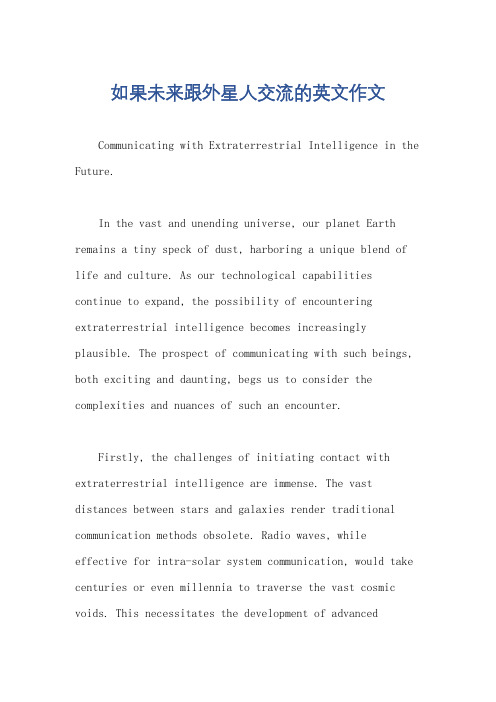
如果未来跟外星人交流的英文作文Communicating with Extraterrestrial Intelligence in the Future.In the vast and unending universe, our planet Earth remains a tiny speck of dust, harboring a unique blend of life and culture. As our technological capabilities continue to expand, the possibility of encountering extraterrestrial intelligence becomes increasingly plausible. The prospect of communicating with such beings, both exciting and daunting, begs us to consider the complexities and nuances of such an encounter.Firstly, the challenges of initiating contact with extraterrestrial intelligence are immense. The vast distances between stars and galaxies render traditional communication methods obsolete. Radio waves, whileeffective for intra-solar system communication, would take centuries or even millennia to traverse the vast cosmic voids. This necessitates the development of advancedtechnologies, such as quantum communication orgravitational wave manipulation, which can traverse vast distances with minimal delay.Once contact is established, the question of how to communicate effectively arises. Language, as we know it, is deeply ingrained in our cultural and historical contexts. Alien civilizations, evolving independently of our own, would likely possess vastly different linguistic systems. To bridge this gap, we would need to develop a universal language or communication protocol that could be understood by both parties. This could be achieved through.。
驾驶飞船探索宇宙作文英语
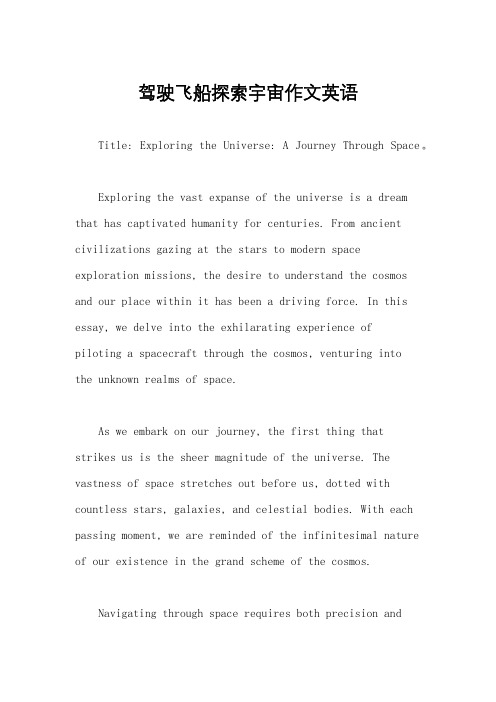
驾驶飞船探索宇宙作文英语Title: Exploring the Universe: A Journey Through Space。
Exploring the vast expanse of the universe is a dream that has captivated humanity for centuries. From ancient civilizations gazing at the stars to modern spaceexploration missions, the desire to understand the cosmos and our place within it has been a driving force. In this essay, we delve into the exhilarating experience ofpiloting a spacecraft through the cosmos, venturing intothe unknown realms of space.As we embark on our journey, the first thing thatstrikes us is the sheer magnitude of the universe. The vastness of space stretches out before us, dotted with countless stars, galaxies, and celestial bodies. With each passing moment, we are reminded of the infinitesimal nature of our existence in the grand scheme of the cosmos.Navigating through space requires both precision andskill. Piloting a spacecraft involves mastering theintricate controls and systems that govern its operation. From maneuvering through asteroid fields to navigating gravitational anomalies, every decision must be made with careful consideration to ensure the safety of the crew and the success of the mission.One of the most awe-inspiring aspects of space exploration is the opportunity to witness the beauty of the universe firsthand. As we travel through the cosmos, we are treated to breathtaking views of distant nebulae, swirling galaxies, and majestic planets. The kaleidoscope of colors and shapes that fill the void of space leaves us in awe of the wonders that lie beyond our home planet.However, space exploration is not without its challenges. The vast distances between celestial bodies mean that travel times can be significant, requiring patience and endurance from the crew. Furthermore, the harsh environment of space presents numerous hazards, from radiation exposure to microgravity effects, which must be carefully mitigated to ensure the health and well-being ofall onboard.Despite these challenges, the rewards of space exploration are immeasurable. From unlocking the mysteries of the cosmos to advancing scientific knowledge and technological innovation, every mission brings us one step closer to understanding the universe and our place within it. Moreover, the spirit of exploration and discovery that drives us to venture into the unknown inspires future generations to continue pushing the boundaries of human achievement.In conclusion, piloting a spacecraft through the cosmos is a thrilling and humbling experience that offers a glimpse into the vastness and beauty of the universe. As we navigate through the endless expanse of space, we are reminded of the boundless potential of human curiosity and ingenuity. With each mission, we come closer to unraveling the secrets of the cosmos and fulfilling humanity's timeless quest for knowledge and exploration.。
英语作文-探索太空奥秘,感受宇宙的神秘
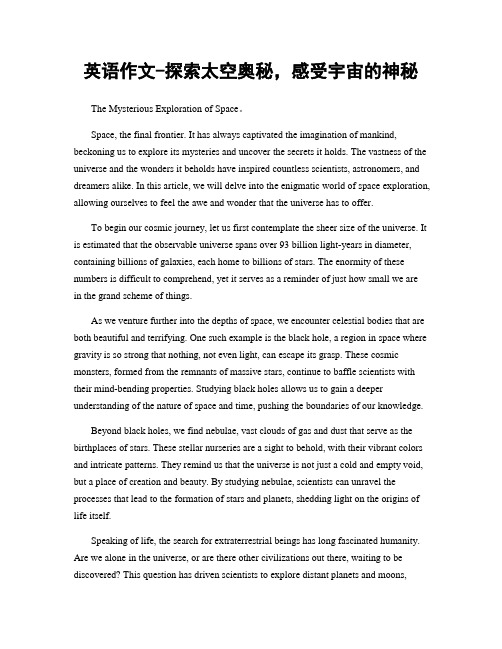
英语作文-探索太空奥秘,感受宇宙的神秘The Mysterious Exploration of Space。
Space, the final frontier. It has always captivated the imagination of mankind, beckoning us to explore its mysteries and uncover the secrets it holds. The vastness of the universe and the wonders it beholds have inspired countless scientists, astronomers, and dreamers alike. In this article, we will delve into the enigmatic world of space exploration, allowing ourselves to feel the awe and wonder that the universe has to offer.To begin our cosmic journey, let us first contemplate the sheer size of the universe. It is estimated that the observable universe spans over 93 billion light-years in diameter, containing billions of galaxies, each home to billions of stars. The enormity of these numbers is difficult to comprehend, yet it serves as a reminder of just how small we arein the grand scheme of things.As we venture further into the depths of space, we encounter celestial bodies that are both beautiful and terrifying. One such example is the black hole, a region in space where gravity is so strong that nothing, not even light, can escape its grasp. These cosmic monsters, formed from the remnants of massive stars, continue to baffle scientists with their mind-bending properties. Studying black holes allows us to gain a deeper understanding of the nature of space and time, pushing the boundaries of our knowledge.Beyond black holes, we find nebulae, vast clouds of gas and dust that serve as the birthplaces of stars. These stellar nurseries are a sight to behold, with their vibrant colors and intricate patterns. They remind us that the universe is not just a cold and empty void, but a place of creation and beauty. By studying nebulae, scientists can unravel the processes that lead to the formation of stars and planets, shedding light on the origins of life itself.Speaking of life, the search for extraterrestrial beings has long fascinated humanity. Are we alone in the universe, or are there other civilizations out there, waiting to be discovered? This question has driven scientists to explore distant planets and moons,searching for signs of habitability. The discovery of exoplanets, planets outside of our solar system, has opened up new possibilities for finding potential life-supporting environments. While we have yet to find concrete evidence of extraterrestrial life, the search continues, fueled by our insatiable curiosity.Space exploration is not without its challenges. The vast distances involved and the harsh conditions of space pose numerous obstacles for astronauts and robotic missions alike. However, these challenges have not deterred us from pushing the boundaries of exploration. Human missions to the Moon, Mars, and beyond are being planned, with the goal of expanding our presence in space and unlocking its secrets.In conclusion, the exploration of space is a journey of wonder and discovery. From the vastness of the universe to the mysteries of black holes and the beauty of nebulae, space offers a glimpse into the unknown. As we continue to explore and understand the cosmos, we gain a deeper appreciation for our place in the universe and the wonders it holds. The mysteries of space are waiting to be unraveled, and it is up to us to embark on this cosmic adventure.。
探索太空英语作文80字
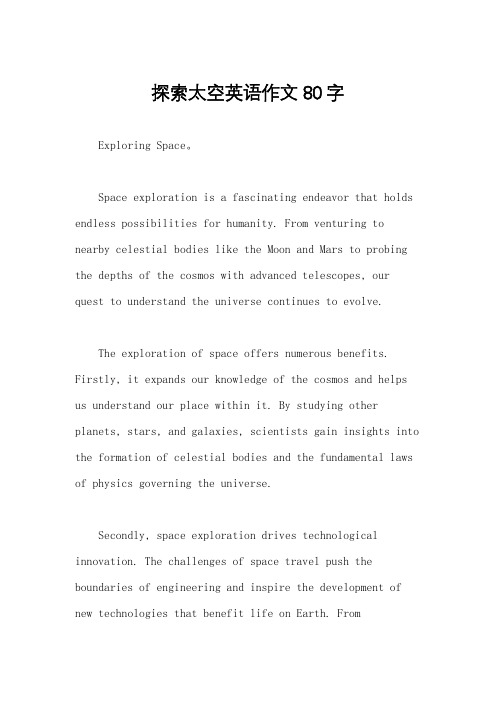
探索太空英语作文80字Exploring Space。
Space exploration is a fascinating endeavor that holds endless possibilities for humanity. From venturing to nearby celestial bodies like the Moon and Mars to probing the depths of the cosmos with advanced telescopes, our quest to understand the universe continues to evolve.The exploration of space offers numerous benefits. Firstly, it expands our knowledge of the cosmos and helps us understand our place within it. By studying other planets, stars, and galaxies, scientists gain insights into the formation of celestial bodies and the fundamental laws of physics governing the universe.Secondly, space exploration drives technological innovation. The challenges of space travel push the boundaries of engineering and inspire the development of new technologies that benefit life on Earth. Fromlightweight materials to advanced propulsion systems, the innovations spurred by space exploration have practical applications in fields such as medicine, communication, and transportation.Moreover, space exploration has the potential to pave the way for future human settlements beyond Earth. Establishing colonies on other planets or moons could ensure the long-term survival of the human species and mitigate the risks associated with overpopulation and environmental degradation on our home planet.Despite these potential benefits, space exploration also poses challenges and ethical considerations. The vast distances involved in interstellar travel present formidable obstacles, including the need for sustainable propulsion systems and life support technologies. Furthermore, questions regarding the exploitation of extraterrestrial resources and the preservation of pristine environments on other celestial bodies require careful ethical deliberation.In conclusion, space exploration holds immense promise for humanity's future. By expanding our understanding of the universe, driving technological innovation, and potentially enabling the colonization of other worlds, it represents a bold frontier of human endeavor. However, we must approach the exploration of space with foresight and responsibility, mindful of both the opportunities and challenges it presents.。
星际旅行英语作文
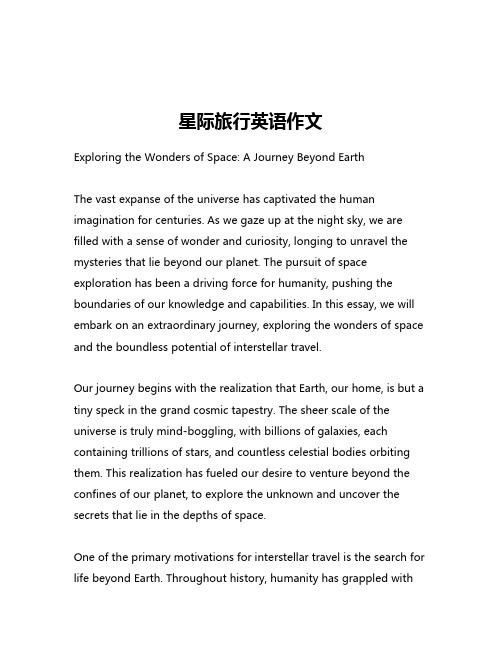
星际旅行英语作文Exploring the Wonders of Space: A Journey Beyond EarthThe vast expanse of the universe has captivated the human imagination for centuries. As we gaze up at the night sky, we are filled with a sense of wonder and curiosity, longing to unravel the mysteries that lie beyond our planet. The pursuit of space exploration has been a driving force for humanity, pushing the boundaries of our knowledge and capabilities. In this essay, we will embark on an extraordinary journey, exploring the wonders of space and the boundless potential of interstellar travel.Our journey begins with the realization that Earth, our home, is but a tiny speck in the grand cosmic tapestry. The sheer scale of the universe is truly mind-boggling, with billions of galaxies, each containing trillions of stars, and countless celestial bodies orbiting them. This realization has fueled our desire to venture beyond the confines of our planet, to explore the unknown and uncover the secrets that lie in the depths of space.One of the primary motivations for interstellar travel is the search for life beyond Earth. Throughout history, humanity has grappled withthe question of whether we are alone in the universe. The discovery of exoplanets, planets orbiting other stars, has ignited a renewed sense of hope that we may not be the only sentient beings in the cosmos. The prospect of encountering intelligent extraterrestrial life has captured the imaginations of scientists and science fiction enthusiasts alike, driving us to develop advanced technologies and strategies for interstellar exploration.As we contemplate the challenges of interstellar travel, we must confront the vast distances that separate us from other celestial bodies. The nearest star system to our own, Proxima Centauri, is a staggering 4.2 light-years away, meaning that it would take our fastest spacecraft over 70,000 years to reach it. This realization highlights the immense technological hurdles we must overcome to make interstellar travel a reality.One of the most promising solutions to this challenge is the development of advanced propulsion systems. From nuclear-powered engines to the theoretical concept of warp drives, scientists are exploring a wide range of innovative technologies that could dramatically reduce the travel time between distant stars. The potential of these systems to revolutionize space exploration is truly exciting, as they could one day allow us to venture to the far reaches of the galaxy and beyond.Alongside advancements in propulsion, the development of life support systems capable of sustaining human life during long-duration space missions is crucial. Astronauts aboard the International Space Station have already demonstrated the ability to live and work in space for extended periods, but the challenges of interstellar travel are far more daunting. Ensuring the health and well-being of explorers during journeys that may last for decades or even centuries is a critical area of research and development.As we contemplate the logistics of interstellar travel, we must also consider the scientific and technological benefits that such endeavors could bring. The study of distant planets, their atmospheres, and their potential for supporting life could yield invaluable insights into the origins of the universe and the evolution of planetary systems. Furthermore, the technological innovations required for interstellar travel could have far-reaching applications in fields such as energy production, materials science, and communications, ultimately benefiting humanity as a whole.The pursuit of interstellar travel is not without its challenges, both practical and ethical. The immense financial and resource investments required to develop the necessary technologies are daunting, and the risks associated with long-duration space missions are significant. Additionally, the ethical implications of interstellar exploration, such as the potential impact on indigenousextraterrestrial life and the responsibility of humanity as a space-faring species, must be carefully considered.Despite these challenges, the lure of the unknown and the promise of unimaginable discoveries continue to drive us forward. As we stand on the cusp of a new era of space exploration, the possibilities are truly limitless. The exploration of other worlds, the search for life beyond our own, and the potential to unlock the secrets of the universe hold the power to transform our understanding of our place in the cosmos.In conclusion, the pursuit of interstellar travel is a testament to the boundless curiosity and ingenuity of the human spirit. As we embark on this extraordinary journey, we are not only expanding the boundaries of our knowledge but also redefining our relationship with the universe. The wonders of space beckon us, and the promise of discovery and understanding compels us to venture forth, to explore the unknown, and to uncover the mysteries that lie beyond our Earth.。
天上与地下的距离英语作文
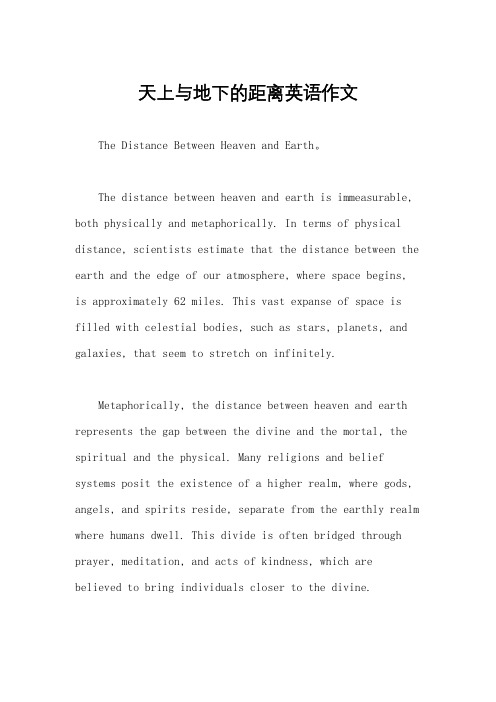
天上与地下的距离英语作文The Distance Between Heaven and Earth。
The distance between heaven and earth is immeasurable, both physically and metaphorically. In terms of physical distance, scientists estimate that the distance between the earth and the edge of our atmosphere, where space begins, is approximately 62 miles. This vast expanse of space is filled with celestial bodies, such as stars, planets, and galaxies, that seem to stretch on infinitely.Metaphorically, the distance between heaven and earth represents the gap between the divine and the mortal, the spiritual and the physical. Many religions and belief systems posit the existence of a higher realm, where gods, angels, and spirits reside, separate from the earthly realm where humans dwell. This divide is often bridged through prayer, meditation, and acts of kindness, which are believed to bring individuals closer to the divine.In literature and art, the concept of the distance between heaven and earth is often explored through themesof transcendence, enlightenment, and the search for meaning. Characters in stories and poems often embark on quests to bridge this gap, seeking wisdom, truth, and a deeper connection to the universe. Artists, too, use their work to explore the mystical and spiritual aspects of this divide, creating pieces that inspire awe and contemplation.In our daily lives, we may feel the distance between heaven and earth in moments of joy, sorrow, or reflection. When we gaze up at the night sky and marvel at the stars,or when we experience a profound sense of peace and connection with the world around us, we may feel a sense of unity with something greater than ourselves. These moments remind us of the vastness of the universe and our place within it, encouraging us to seek meaning and purpose inour lives.Ultimately, the distance between heaven and earth is a reminder of the mysteries and wonders of the world we inhabit. It challenges us to explore the depths of our ownspirituality, to connect with something beyond the material realm, and to strive for a greater understanding of the universe and our place within it. As we navigate this vast and complex world, may we always be mindful of the distance between heaven and earth, and the infinite possibilities that lie within it.。
十三号飞船心得作文英语
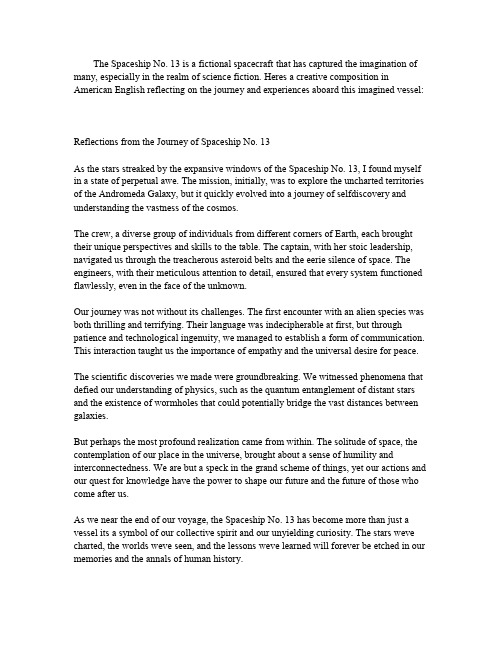
The Spaceship No. 13 is a fictional spacecraft that has captured the imagination of many, especially in the realm of science fiction. Heres a creative composition in American English reflecting on the journey and experiences aboard this imagined vessel: Reflections from the Journey of Spaceship No. 13As the stars streaked by the expansive windows of the Spaceship No. 13, I found myself in a state of perpetual awe. The mission, initially, was to explore the uncharted territories of the Andromeda Galaxy, but it quickly evolved into a journey of selfdiscovery and understanding the vastness of the cosmos.The crew, a diverse group of individuals from different corners of Earth, each brought their unique perspectives and skills to the table. The captain, with her stoic leadership, navigated us through the treacherous asteroid belts and the eerie silence of space. The engineers, with their meticulous attention to detail, ensured that every system functioned flawlessly, even in the face of the unknown.Our journey was not without its challenges. The first encounter with an alien species was both thrilling and terrifying. Their language was indecipherable at first, but through patience and technological ingenuity, we managed to establish a form of communication. This interaction taught us the importance of empathy and the universal desire for peace.The scientific discoveries we made were groundbreaking. We witnessed phenomena that defied our understanding of physics, such as the quantum entanglement of distant stars and the existence of wormholes that could potentially bridge the vast distances between galaxies.But perhaps the most profound realization came from within. The solitude of space, the contemplation of our place in the universe, brought about a sense of humility and interconnectedness. We are but a speck in the grand scheme of things, yet our actions and our quest for knowledge have the power to shape our future and the future of those who come after us.As we near the end of our voyage, the Spaceship No. 13 has become more than just a vessel its a symbol of our collective spirit and our unyielding curiosity. The stars weve charted, the worlds weve seen, and the lessons weve learned will forever be etched in our memories and the annals of human history.In conclusion, the journey of the Spaceship No. 13 was not just an expedition into the cosmos it was an odyssey into the depths of our own humanity. As we prepare to return to Earth, we carry with us not only the knowledge of the universe but also a renewed sense of purpose and a deeper connection to the cosmos we inhabit.This composition captures the essence of a space journey, blending scientific curiosity with philosophical reflection, all while maintaining the excitement and wonder that space exploration inspires.。
科幻作文英语加翻译中文
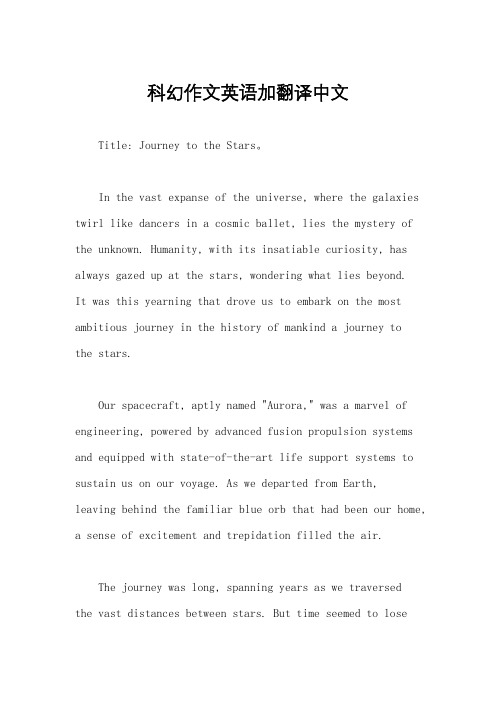
科幻作文英语加翻译中文Title: Journey to the Stars。
In the vast expanse of the universe, where the galaxies twirl like dancers in a cosmic ballet, lies the mystery of the unknown. Humanity, with its insatiable curiosity, has always gazed up at the stars, wondering what lies beyond.It was this yearning that drove us to embark on the most ambitious journey in the history of mankind a journey tothe stars.Our spacecraft, aptly named "Aurora," was a marvel of engineering, powered by advanced fusion propulsion systems and equipped with state-of-the-art life support systems to sustain us on our voyage. As we departed from Earth,leaving behind the familiar blue orb that had been our home, a sense of excitement and trepidation filled the air.The journey was long, spanning years as we traversedthe vast distances between stars. But time seemed to loseits meaning as we delved deeper into the unknown reaches of space. We encountered phenomena beyond our wildest imagination pulsars that sang strange melodies, nebulaethat shimmered with colors unseen by human eyes, and planets that defied conventional understanding.But amidst the wonders of the cosmos, there were also dangers lurking in the shadows. Cosmic radiation threatened to fry our delicate instruments, and micrometeoroids posed a constant risk to our hull. Yet, with each obstacle we faced, we pressed on, driven by our unyielding determination to reach our destination.Finally, after what felt like an eternity, we arrived at our destination a distant star system with planets that held the promise of new beginnings. As we descended towards the surface of the most promising planet, a sense of awe washed over us. This was a world untouched by human hands, a blank canvas upon which we could paint the dreams of generations.But as we set foot on this alien world, we realizedthat our journey was far from over. The challenges of colonization lay ahead building habitats to shield us from the harsh environment, terraforming the landscape to makeit hospitable to human life, and forging new societies from the ashes of the old.Yet, despite the challenges that lay ahead, we knewthat this was a journey worth taking. For in the vast expanse of the universe, we had found not only new worlds to explore but also the boundless potential of the human spirit.我们置身于宇宙的广袤中,星系如舞者在宇宙的舞台上旋转,而未知的奥秘就躲藏在其中。
宇宙有多大的英语作文
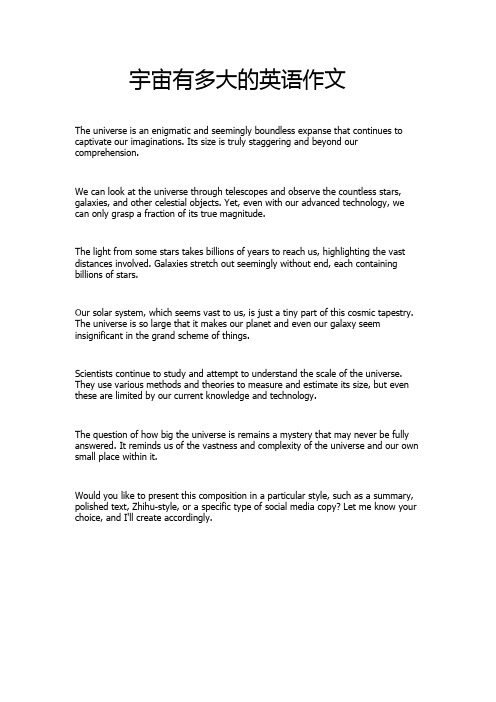
宇宙有多大的英语作文The universe is an enigmatic and seemingly boundless expanse that continues to captivate our imaginations. Its size is truly staggering and beyond our comprehension.We can look at the universe through telescopes and observe the countless stars, galaxies, and other celestial objects. Yet, even with our advanced technology, we can only grasp a fraction of its true magnitude.The light from some stars takes billions of years to reach us, highlighting the vast distances involved. Galaxies stretch out seemingly without end, each containing billions of stars.Our solar system, which seems vast to us, is just a tiny part of this cosmic tapestry. The universe is so large that it makes our planet and even our galaxy seem insignificant in the grand scheme of things.Scientists continue to study and attempt to understand the scale of the universe. They use various methods and theories to measure and estimate its size, but even these are limited by our current knowledge and technology.The question of how big the universe is remains a mystery that may never be fully answered. It reminds us of the vastness and complexity of the universe and our own small place within it.Would you like to present this composition in a particular style, such as a summary, polished text, Zhihu-style, or a specific type of social media copy? Let me know your choice, and I'll create accordingly.。
- 1、下载文档前请自行甄别文档内容的完整性,平台不提供额外的编辑、内容补充、找答案等附加服务。
- 2、"仅部分预览"的文档,不可在线预览部分如存在完整性等问题,可反馈申请退款(可完整预览的文档不适用该条件!)。
- 3、如文档侵犯您的权益,请联系客服反馈,我们会尽快为您处理(人工客服工作时间:9:00-18:30)。
a rXiv:as tr o-ph/991331v123Jan1999DIRECT Distances to Nearby Galaxies Using Detached Eclipsing Binaries and Cepheids.III.Variables in the Field M31C 1K.Z.Stanek 2Harvard-Smithsonian Center for Astrophysics,60Garden St.,MS20,Cambridge,MA 02138e-mail:kstanek@ J.Kaluzny Warsaw University Observatory,Al.Ujazdowskie 4,PL-00-478Warszawa,Poland e-mail:jka@.pl M.Krockenberger,D.D.Sasselov Harvard-Smithsonian Center for Astrophysics,60Garden St.,MS16,Cambridge,MA 02138e-mail:krocken@,sasselov@ J.L.Tonry University of Hawaii,Institute for Astronomy,2680Woodlawn Dr.,Honolulu,HI 96822e-mail:jt@ M.Mateo Department of Astronomy,University of Michigan,821Dennison Bldg.,Ann Arbor,MI 48109–1090e-mail:mateo@ ABSTRACT We undertook a long term project,DIRECT,to obtain the direct distances to two important galaxies in the cosmological distance ladder –M31and M33–using detached eclipsing binaries (DEBs)and Cepheids.While rare and difficult to detect,DEBs provide us with the potential to determine these distances with an accuracybetter than 5%.The extensive photometry obtained in order to detect DEBs providesus with good light curves for the Cepheid variables.These are essential to the parallelproject to derive direct Baade-Wesselink distances to Cepheids in M31and M33.For both Cepheids and eclipsing binaries,the distance estimates will be free of anyintermediate steps.As a first step in the DIRECT project,between September 1996and October 1997we obtained 95full/partial nights on the F.L.Whipple Observatory 1.2m telescopeand36full nights on the Michigan-Dartmouth-MIT1.3m telescope to search for DEBsand new Cepheids in the M31and M33galaxies.In this paper,third in the series,wepresent the catalog of variable stars,most of them newly detected,found in thefieldM31C[(α,δ)=(11.◦10,41.◦42),J2000.0].We have found115variable stars:12eclipsingbinaries,35Cepheids and68other periodic,possible long period or non-periodicvariables.The catalog of variables,as well as their photometry andfinding charts,isavailable via anonymous ftp and the World Wide Web.The complete set of the CCDframes is available upon request.Subject headings:binaries:eclipsing—Cepheids—distance scale—galaxies:individual(M31)—stars:variables:other1.IntroductionThe two nearby galaxies M31and M33are stepping stones to most of our current effort to understand the evolving universe at large scales.First,they are essential to the calibration of the extragalactic distance scale(Jacoby et al.1992;Tonry et al.1997).Second,they constrain population synthesis models for early galaxy formation and evolution and provide the stellar luminosity calibration.There is one simple requirement for all this—accurate distances.Detached eclipsing binaries(DEBs)have the potential to establish distances to M31and M33 with an unprecedented accuracy of better than5%and possibly to better than1%.These distances are now known to no better than10-15%,as there are discrepancies of0.2−0.3mag between RR Lyrae and Cepheids distance indicators(e.g.Huterer,Sasselov&Schechter1995;Holland1998; Stanek&Garnavich1998).Detached eclipsing binaries(for reviews see Andersen1991;Paczy´n ski 1997)offer a single step distance determination to nearby galaxies and may therefore provide an accurate zero point calibration—a major step towards very accurate determination of the Hubble constant,presently an important but daunting problem for astrophysicists.The detached eclipsing binaries have yet to be used(Huterer et al.1995;Hilditch1996)as distance indicators to M31and M33.According to Hilditch(1996),there were about60eclipsing binaries of all kinds known in M31(Gaposchkin1962;Baade&Swope1963,1965)and only one in M33(Hubble1929).Only now does the availability of large-format CCD detectors and inexpensive CPUs make it possible to organize a massive search for periodic variables,which will produce a handful of good DEB candidates.These can then be spectroscopically followed-up with the powerful new6.5-10meter telescopes.The study of Cepheids in M31and M33has a venerable history(Hubble1926,1929; Gaposchkin1962;Baade&Swope1963,1965).In the1980s,Freedman&Madore(1990)and Freedman,Wilson,&Madore(1991)studied small samples of the earlier discovered Cepheids, to build period-luminosity(P-L)relations in M31and M33,respectively.However,both thesparse photometry and the small samples do not provide a good basis for obtaining direct Baade-Wesselink distances(see,e.g.,Krockenberger,Sasselov&Noyes1997)to Cepheids—the need for new digital photometry has been long overdue.Recently,Magnier et al.(1997)surveyed large portions of M31,which have previously been ignored,and found some130new Cepheid variable candidates.Their light curves are,however,rather sparsely sampled and in the V-band only.In Kaluzny et al.(1998,hereafter:Paper I)and Stanek et al.(1998,hereafter:Paper II),the first two papers of the series,we presented the catalogs of variable stars found in twofields in M31,called M31B and M31A.Here we present the catalog of variables from the nextfield M31C. In Sec.2we discuss the selection of thefields in M31and the observations.In Sec.3we describe the data reduction and calibration.In Sec.4we discuss briefly the automatic selection we used forfinding the variable stars.In Sec.5we discuss the classification of the variables.In Sec.6we present the catalog of variable stars,followed by brief discussion of the results in Sec.7.2.Fields selection and observationsM31was primarily observed with the1.3m McGraw-Hill Telescope at the Michigan-Dartmouth-MIT(MDM)Observatory.We used the front-illuminated,Loral20482CCD“Wilbur”(Metzger,Tonry&Luppino1993),which at the f/7.5station of the1.3m telescope has a pixel scale of0.32arcsec pixel−1andfield of view of roughly11arcmin.We used Kitt Peak Johnson-Cousins BV Ifilters.Data for M31were also obtained,mostly in1997,with the1.2m telescope at the F.L.Whipple Observatory(FLWO),where we used“AndyCam”(Szentgyorgyi et al.1998),with a thinned,back-side illuminated,AR coated Loral20482pixel CCD.The pixel scale happens to be essentially the same as at the MDM1.3m telescope.We used standard Johnson-Cousins BV Ifilters.Fields in M31were selected using the MIT photometric survey of M31by Magnier et al.(1992) and Haiman et al.(1994)(see Paper I,Fig.1).We selected six11′×11′fields,M31A–F,four of them(A–D)concentrated on the rich spiral arm in the northeast part of M31,one(E)coinciding with the region of M31searched for microlensing by Crotts&Tomaney(1996),and one(F) containing the giant star formation region known as NGC206(observed by Baade&Swope1963). Fields A–C were observed during September and October1996five to eight times per night in the V band,resulting in total of110–160V exposures perfield.Fields D–F were observed once a night in the V-band.Some exposures in B and I were also taken.M31was also observed,in1996 and1997,at the FLWO1.2m telescope,whose main target was M33.In this paper we present the results for the M31Cfield.We obtained for thisfield useful data during29nights at the MDM,collecting a total of141×900sec exposures in V and30×600sec exposures in I.We also obtained for thisfield useful data during24nights at the FLWO,in 1996and1997,collecting a total of20×900sec exposures in V,25×600sec exposures in I and10×1200sec exposures of B.33.Data reduction,calibration and astrometryThe details of the reduction procedure were given in Paper I.Preliminary processing of the CCD frames was done with the standard routines in the IRAF-CCDPROC package.4Stellar profile photometry was extracted using the Daophot/Allstar package(Stetson1987,1992).We selected a “template”frame for eachfilter using a single frame of particularly good quality.These template images were reduced in a standard way(Paper I).Other images were reduced using Allstar in the fixed-position-mode using as an input the transformed object list from the template frames.For each frame the list of instrumental photometry derived for a given frame was transformed to the common instrumental system of the appropriate“template”image.Photometry obtained for the B,V and Ifilters was combined into separate data bases.M31C images obtained at the FLWO were reduced using MDM“templates”.In case of B-band images obtained at FLWO we used the V-band MDM template tofix the positions of the stars.The photometric V I calibration of the MDM data was discussed in Paper I.In addition,for thefield M31C on the night of1997October9/10we have obtained independent BV I calibration with the FLWO1.2m telescope.There was an offset of0.012mag in V and0.024mag in V−I between the FLWO and the MDM calibration,i.e.well within our estimate of the total0.05mag systematic error discussed in Paper I.We also derived equatorial coordinates for all objects included in the data bases for the Vfilter.The transformation from rectangular coordinates to equatorial coordinates was derived using∼200stars identified in the list published by Magnier et al.(1992).4.Selection of variablesThe procedure for selecting the variables was described in detail in Paper I,so here we only give a short description,noting changes when necessary.The reduction procedure described in previous section produces databases of calibrated BV I magnitudes and their standard errors. The BV databases for M31Cfield contain15120stars,with up to161measurements in V and up to10measurements in B,and the I database contains28441stars with up to55measurements.Fig.1.—Distributions in B(dotted line),V(dashed line)and I(continuous line)of stars in the field M31C.Figure1shows the distributions of stars as a function of mean¯B,¯V or¯I magnitude.As can be seen from the shape of the histograms,our completeness starts to drop rapidly at about¯B∼23,¯V∼22and¯I∼20.5.The primary reason for this difference in the depth of the photometry between BV and I is the level of the combined sky and background light,which is about three times higher in the Ifilter than in the BVfilters.The measurementsflagged as“bad”and measurements with errors exceeding the average error by more than4σare removed(Paper I).Usually zero to10points are removed,leaving the majority of stars with roughly N good∼150−160V measurements.For further analysis we use only those stars that have at least N good>N max/2(=80)measurements.There are11263such stars in the V database of the M31Cfield.Our next goal is to select objectively a sample of variable stars from the total sample defined above.There are many ways to proceed,and we largely follow the approach of Stetson(1996). The procedure is described in more detail in Paper I.In short,for each star we compute the Stetson’s variability index J S(Paper I,Eq.7),and stars with values exceeding some minimum value J S,min are considered candidate variables.The definition of Stetson’s variability index includes the standard errors of individual observations.If,for some reason,these errors were over-or underestimated,we would either miss real variables,or select spurious variables as real ones. Using the procedure described in Paper I,we scale the Daophot errors to better represent the “true”photometric errors.We then select the candidate variable stars by computing the value ofFig. 2.—Variability index J S vs.mean¯V magnitude for11262stars in thefield M31C with N good>80.Dashed line at J S=0.75defines the cutoffapplied for variability.J S for the stars in our V database.We used a cutoffof J S,min=0.75and additional cuts described in Paper I to select313candidate variable stars(about3%of the total number of11263).In Figure2we plot the variability index J S vs.apparent visual magnitude¯V for11262stars with N good>80.5.Period determination,classification of variablesWe based our candidate variables selection on the V band data collected at the MDM and the FLWO telescopes.We also have the BI-bands data for thefield,up to55I-band epochs and up to10B-band epochs,although for a variety of reasons some of the candidate variable stars do not have an B or I-band counterpart.We will therefore not use the BI data for the period determination and broad classification of the variables.We will however use the BI data for the “final”classification of some variables.Next we searched for the periodicities for all313candidate variables,using a variant of the Lafler-Kinman(1965)technique proposed by Stetson(1996).Starting with the minimum period of0.25days,successive trial periods are chosen soP−1 j+1=P−1j−0.02150days.For each candidate variable10best trial periods are selected(Paper I)and then used in our classification scheme.The variables we are most interested in are Cepheids and eclipsing binaries(EBs).We therefore searched our sample of variable stars for these two classes of variables.As mentioned before,for the broad classification of variables we restricted ourselves to the V band data.We will,however,present and use the BI-bands data,when available,when discussing some of the individual variable stars.For EBs we used search strategy described in Paper II.Within our assumption the light curve of an EB is determined by nine parameters:the period,the zero point of the phase,the eccentricity,the longitude of periastron,the radii of the two stars relative to the binary separation, the inclination angle,the fraction of light coming from the bigger star and the uneclipsed magnitude.A total of17variables passed all of the criteria.We then went back to the CCD frames and tried to see by eye if the inferred variability is indeed there,especially in cases when the light curve is very noisy/chaotic.We decided to removefive dubious eclipsing binaries.The remaining12EBs with their parameters and light curves are presented in the Section6.1.In the search for Cepheids we followed the approach by Stetson(1996)offitting template light curves to the data.We used the parameterization of Cepheid light curves in the V-band as given by Stetson(1996).There was a total of100variables passing all of the criteria(Paper I and II), but after investigating the CCD frames we removed28dubious“Cepheids”,which leaves us with 62probable Cepheids.Their parameters and light curves are presented in the Sections6.2,6.3.After the preliminary selection of17eclipsing binaries and100possible Cepheids,we were left with197“other”variable stars.After raising the threshold of the variability index to J S,min=1.2 (Paper I)we are left with61variables.After investigating the CCD frames we removed30dubious variables from the sample,which leaves31variables which we classify as miscellaneous.Their parameters and light curves are presented in the Section6.4.6.Catalog of variablesIn this section we present light curves and some discussion of the115variable stars discovered by our survey in thefield M31C.5The variable stars are named according to the following convention:letter V for“variable”,the number of the star in the V database,then the letter “D”for our project,DIRECT,followed by the name of thefield,in this case(M)31C,e.g.V9037 D31C.Tables1,2,3and4list the variable stars sorted broadly by four categories:eclipsing binaries,Cepheids,other periodic variables and“miscellaneous”variables,in our case meaning“variables with no clear periodicity”.Some of the variables which were found independently by survey of Magnier et al.(1997)are denoted in the“Comments”by“Ma97ID”,where the“ID”is the identification number assigned by Magnier at al.(1997).We also cross-identify several variables found by us in Paper I.6.1.Eclipsing binariesIn Table1we present the parameters of the12eclipsing binaries in the M31Cfield.The lightcurves of these variables are shown in Figure3,along with the simple eclipsing binary models discussed in the Paper I.The variables are sorted in the Table1by the increasing value of the period P.For each eclipsing binary we present its name,J2000.0coordinates(in degrees),period P,magnitudes V max,I max and B max of the system outside of the eclipse,and the radii of the binary components R1,R2in the units of the orbital separation.We also give the inclination angle of the binary orbit to the line of sight i and the eccentricity of the orbit e.The reader should bear in mind that the values of V max,I max,B max,R1,R2,i and e are derived with a straightforward model of the eclipsing system,so they should be treated only as reasonable estimates of the“true”value.One of the eclipsing binaries found,V9037D31C,is a very good DEB candidate,with deep eclipses and the ellipticity indicating that the system is young and unevolved.However,much better light curve is necessary to accurately establish the properties of the system.Two other systems,V10732and V14662D31C,also seem to be detached,but they are significantly fainter than V9037D31C and therefore less suitable for follow-up.Inspection of the V,B−V color-magnitude diagram(Figure4)reveals that one of the candidate eclipsing binaries lands close to the Cepheid portion of the CMD.It turns out that this variable,V14396D31C,is only marginally betterfit by a eclipsing binary light curve than by a Cepheid light curve with roughly half of the period,but we decided to keep it classified as an eclipsing binary.6.2.CepheidsIn Table2we present the parameters of35Cepheids in the M31Cfield,sorted by the period P.For each Cepheid we present its name,J2000.0coordinates,period P,flux-weighted mean magnitudes V and(when available) I and B ,and the V-band amplitude of the variation A.In Figure5we show the phased B,V,I lightcurves of our Cepheids.Also shown is the best fit template lightcurve(Stetson1996),which wasfitted to the V data and then for the I data only the zero-point offset was allowed.For the B-band data,lacking the template lightcurve parameterization(Stetson1996),we used the V-band template,allowing for different zero-points and amplitudes.With our limited amounts of B-band data this approach produces mostlyTable1.DIRECT Eclipsing Binaries in M31CNameαJ2000.0δJ2000.0P i(D31C)(deg)(deg)(days)V max I max B max R1R2(deg)e Comments Note.—V9037D31C with period P=5.7735days is a good detached eclipsing binary(DEB)candidate,with significant eccentricity.V12594D31C was found in Paper I as V2763D31B,with P=2.302days,V max=20.51and I max=20.84.Fig.3.—BV I lightcurves of eclipsing binaries found in thefield M31C.The thin continuous line represents the bestfit model for each star and photometric band.B-band lightcurve is shown in the bottom panel and I-band lightcurve(when present)is shown in the top panel.Fig.3.—Continued.Fig.3.—Continued.Fig.4.—V,V−I(upper panels)and B,B−V(lower panels)color-magnitude diagrams for the variable stars found in thefield M31C.The eclipsing binaries and Cepheids are plotted in the left panels and the other periodic variables and miscellaneous variables are plotted in the right panels. The dashed lines correspond to the I detection limit of I∼21mag(upper panels)and the B detection limit of B∼23.5mag(lower panels).satisfactory results,but extending the template-fitting approach of Stetson(1996)to the B-band (and possibly other popular bands)would be most useful.6.3.Other periodic variablesFor many of the variables preliminary classified as Cepheids we decided upon closer examination to classify them as“other periodic variables”.In Table3we present the parameters of 37possible periodic variables,other than Cepheids and eclipsing binaries,in the M31Cfield,sorted by the increasing period P.For each variable we present its name,J2000.0coordinates,period P, error-weighted mean magnitudes¯V and(when available)¯I,¯B.To quantify the amplitude of the variability,we also give the standard deviations of the measurements in the BV I bands,σV,σI andσB.Note that in most cases the periods were derived byfitting the template Cepheids lightcurves, so they should only be treated as thefirst approximation of the true period.Many of these periodic variables are Type II Cepheids(W Virginis and RV Tauri variables),based on their light curves and their location on the P-L diagram(Figure7).6.4.Miscellaneous variablesIn Table4we present the parameters of31miscellaneous variables in the M31Cfield,sorted by increasing value of the mean magnitude¯V.For each variable we present its name,J2000.0 coordinates and mean magnitudes¯V,¯I and¯B.To quantify the amplitude of the variability,we also give the standard deviations of the measurements in V IB bands,σV,σI andσB.In the “Comments”column we give a rather broad sub-classification of the variability:LP–possible long-period variable;Irr–irregular variable.In Figure8we show the unphased V I lightcurves of the miscellaneous variables.Most of the miscellaneous variables seem to represent the LP type of variability,with few variables showing irregular variations.However,inspection of the color-magnitude diagram (Figure4)reveals that many of the miscellaneous variables land in the CMD in the same area as the RV Tau variables,which suggests they are Type II Cepheids.parison with other catalogsThe area of M31Cfield has not been observed frequently before and the only overlapping variable star catalog is given by Magnier et al.(1997,hereafter Ma97).Out of14variable stars in Ma97which are located in our M31Cfield,we cross-identified13.Of these13stars,four(Ma97 79,84,88,91)we did not classify as variables(J S=0.72,−0.04,0.34,0.43).Of the remainingFig.5.—BV I lightcurves of Cepheid variables found in thefield M31C.The thin continuous line represents the bestfit Cepheid template for each star and photometric band.B(if present)is always the faintest and I(if present)is always the brightest.Fig.5.—Continued.Fig.5.—Continued.Fig.5.—Continued.Fig.5.—Continued.Fig.5.—Continued.Fig.6.—BV I lightcurves of other periodic variables found in thefield M31C.B-band data(shown with the open circles,if present)is usually the faintest and I(if present)is usually the brightest.Fig.6.—Continued.Fig.6.—Continued.Fig.6.—Continued.Fig.6.—Continued.Fig.6.—Continued.Table2.DIRECT Cepheids in M31CNameαJ2000.0δJ2000.0P(D31C)(deg)(deg)(days) V I B A Comments Note.—V10846D31C was found in Paper I as V1562D31B,with P=7.784days, V =21.20 and I =20.43;V9544D31C was found as V643D31B,with P=7.889days, V =20.39and I =19.52;V8771D31C was found as V129D31B,with P=8.242days, V =20.74and I =19.58;V12902D31C was found as V2977D31B,with P=8.518days, V =21.80and I =20.40.Table3.DIRECT Other Periodic Variables in M31CNameαJ2000.0δJ2000.0P(D31C)(deg)(deg)(days)¯V¯I¯BσVσIσB CommentsTable4.DIRECT Miscellaneous Variables in M31CNameαJ2000.0δJ2000.0(D31C)(deg)(deg)¯V¯I¯BσVσIσB Comments Note.—Variables V14370D31C was also found in Paper I.nine stars we have classified eight as Cepheids and one as an eclipsing binary(see Tables1,2for cross-ids).There was also by design a slight overlap between the M31C and M31Bfields(Figure9).There were four Cepheids from the M31Cfield in the overlap region,and they were all cross-identified in the M31B catalog,with very similar properties of their light curves(see Table2).There was only one eclipsing binary in the overlap from the M31Cfield,V12594D31C,and it was cross-identified as V2763D31B,again with very similar properties of its light curve(see Table1).We also cross-identified one miscellaneous variable(see Table4),out of three detected in the M31Bfield and one detected in the M31Cfield,which fell into the overlap region.7.DiscussionIn Figure4we show V,V−I and V,B−V color-magnitude diagrams for the variable stars found in thefield M31C.The eclipsing binaries and Cepheids are plotted in the left panels and the other periodic variables and miscellaneous variables are plotted in the right panels.As expected,most of the eclipsing binaries occupy the blue upper main sequence of M31stars,with the exception of the bright,probably foreground,W UMa system V13944D31C.The Cepheid variables group near B−V∼1.0,with considerable scatter probably due to differential reddening across thefield.The other periodic variable stars have positions on the CMD similar to the Cepheids.The miscellaneous variables are scattered throughout the CMDs and represent several classes of variability.Many of them are very red with V−I>2.0,and are probably Mira variables. Several brightest miscellaneous variables are probably foreground stars belonging to our Galaxy.In Figure9we plot the location of eclipsing binaries and Cepheids in thefields M31C and M31B,along with the blue stars(B−V<0.4)selected from the photometric survey of M31by Magnier et al.(1992)and Haiman et al.(1994).The sizes of the circles representing the Cepheids variables are proportional to the logarithm of their period.As could have been expected,both types of variables group along the spiral arms,as they represent relatively young populations of stars.We will explore various properties of our sample of Cepheids in the future paper(Sasselov et al.1999,in preparation).We would like to thank the TAC of the Michigan-Dartmouth-MIT(MDM)Observatory and the TAC of the F.L.Whipple Observatory(FLWO)for the generous amounts of telescope time devoted to this project.We are very grateful to Bohdan Paczy´n ski for motivating us to undertake this project and his always helpful comments and suggestions.We thank Lucas Macri for taking some of the data described in this paper and Przemek Wo´z niak for his FITS-manipulation programs.The staffof the MDM and the FLWO observatories is thanked for their support during the long observing runs.KZS was supported by the Harvard-Smithsonian Center for Astrophysics Fellowship.JK was supported by NSF grant AST-9528096to Bohdan Paczy´n ski and by the PolishKBN grant2P03D011.12.JLT was supported by the NSF grant AST-9401519.REFERENCESAndersen,J.1991,A&AR,3,91Baade,W.,Swope,H.H.1963,AJ,68,435Baade,W.,Swope,H.H.1965,AJ,70,212Crotts,A.P.S.,&Tomaney,A.B.1996,ApJ,473,L87Freedman,W.L.,&Madore,B.F.1990,ApJ,365,186Freedman,W.L.,Wilson,C.D.,&Madore,B.F.1991,ApJ,372,455Gaposchkin,S.1962,AJ,67,334Haiman,Z.,et al.1994,A&A,286,725Hilditch,R.W.1996,in:ASP Conf.Ser.90,The Origins,Evolution and Destinies of Binary Stars in Clusters,one&J.-C.Mermilliod(San Francisco:ASP),207 Holland,S.1998,AJ,115,1916Hubble,E.1926,ApJ,63,236Hubble,E.1929,ApJ,69,103Huterer,D.,Sasselov,D.D.,Schechter,P.L.1995,AJ,100,2705Jacoby,G.H.,et al.1992,PASP,104,599Kaluzny,J.,Stanek,K.Z.,Krockenberger,M.,Sasselov,D.D.,Tonry,J.L.,&Mateo,M.1998, AJ,115,1016(Paper I)Krockenberger,M.,Sasselov,D.D.,&Noyes,R.1997,ApJ,479,875Lafler,J.,&Kinman,T.D.1965,ApJS,11,216Landolt,A.1992,AJ,104,340Magnier,E.A.,Augusteijn,T.,Prins,S.,van Paradijs,J.,&Lewin,W.H.G.1997,A&AS,126, 401(Ma97)Magnier,E.A.,Lewin,W.H.G.,Van Paradijs,J.,Hasinger,G.,Jain,A.,Pietsch,W.,& Truemper,J.1992,A&AS,96,37Metzger,M.R.,Tonry,J.L.,&Luppino,G.A.1993,in ASP Conf.Ser.52,Astronomical Data Analysis Software and Systems II,ed.R.J.Hanisch,R.J.V.Brissenden,&J.Barnes, (San Francisco:ASP),300Paczy´n ski,B.1997,in The Extragalactic Distance Scale,ed.M.Livio,M.Donahue&N.Panagia (Cambridge:Cambridge Univ.Press),273Sasselov,D.D.,et al.1999,in preparationStanek,K.Z.,Kaluzny,J.,Krockenberger,M.,Sasselov,D.D.,Tonry,J.L.,&Mateo,M.1998, AJ,115,1894(Paper II)Stanek.K.Z.,&Garnavich,P.M.1998,ApJ,503,L131Stetson,P.B.1987,PASP,99191Stetson,P.B.1992,in ASP Conf.Ser.25,Astrophysical Data Analysis Software and Systems I, ed.D.M.Worrall,C.Bimesderfer,&J.Barnes(San Francisco:ASP),297Stetson,P.B.1996,PASP,108,851Szentgyorgyi,A.,et al.1999,in preparationTonry,J.L.,Blakeslee,J.P.,Ajhar,E.A.,&Dressler,A.,1997,ApJ,475,399。
